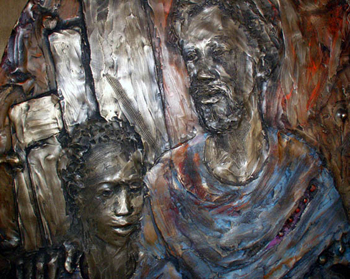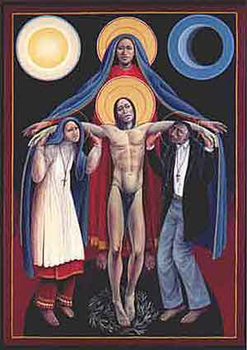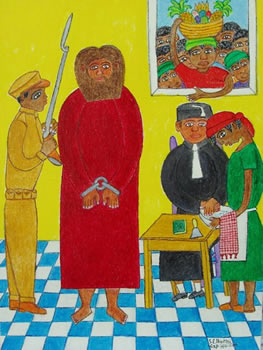From Our Archives
Debie Thomas, But What Do You Think? (2020); and Dan Clendenin, Yes and No (2017).
For Sunday August 27, 2023
Lectionary Readings (Revised Common Lectionary, Year A)
Exodus 1:8–2:10 or Isaiah 51:1–6
Psalm 124 or Psalm 138
Romans 12:1–8
Matthew 16:13–20
This Week's Essay
But What About You?
Here’s a thought experiment to try some time — what are your earliest memories of Jesus? There’s a good chance you might visualize a painting by Warner Sallman, The Head of Christ (1940), which has been reproduced some 500 million times. The painting originated in Protestant America, and was subsequently venerated by Catholic and Orthodox believers around the world. It's been credited with at least one miracle, and is the subject of a book by Yale University Press (David Morgan, Icons of American Protestantism: The Art of Warner Sallman, 1996).
Sallman’s Jesus encourages what Don McCullough calls "the dangerous illusion of a manageable deity." He has flowing blond hair and saccharine blue eyes. He stares into space. He is clean, safe, passive, and effeminate, which is maybe why Christians have plastered this image in Sunday school rooms all over the world. It's hard to imagine why such a harmless person would be arrested by Rome, beaten to a pulp, and crucified as a criminal; he wouldn't hurt a flea.
We shouldn’t be too critical of such popular images of Jesus. Even cultural kitsch expresses the everyday longings of ordinary Christians. And besides, among scholars there’s hardly any agreement about the identity of Jesus, but rather a bewildering array of conflicting opinions — Jesus was a peasant cynic, economic egalitarian, political liberator, hippie healer, apocalyptic prophet, or messianic Jew.
 |
|
Head of Christ by Warner Sallman (1940).
|
The assumption of most scholars is that if we could get behind the fanciful post-Easter "Christ of faith" that was fabricated by the first believers, and discover the authentic pre-Easter "Jesus of history," then he'd make more sense to us. I’d say two things about this scholarly orthodoxy.
First, the historian Garry Wills has suggested that if we really did know more about the “historical” Jesus, he would become more rather than less mysterious to us. And second, in his book The Quest for the Historical Jesus (1906), Albert Schweitzer famously compared the 19th-century liberal search for the "real" Jesus, scrubbed clean of centuries of historical accretions, to scholars gazing down a well and seeing only their own reflections.
Whether popular or scholarly, nobody has an interpretive monopoly on Jesus. We’re all inclined to create him in our own image, according to our own time, place, purpose, and culture. There’s the Jesus of European colonizers, the Jesus of German intellectuals and of Guatemalan Indians, the Jesus of stage, theater, song and film — remember the 1971 rock opera Jesus Christ Superstar by Andrew Lloyd Webber? Thomas Jefferson took scissors to everything that offended his eighteenth-century concept of reason in the Gospels, and ended up with a Jesus who was little more than a mild humanitarian moralizer. George Bush claimed Jesus as his favorite political philosopher. In the first chapter of his book A Generous Orthodoxy (2004), Brian McLaren explores "The Seven Jesuses I Have Known."
 |
|
Black Joseph with the Young Jesusby Wiktor Szostalo.
|
These malleable, complementary, and sometimes conflicting images of Jesus are fascinating at a cultural or sociological level. Practically speaking, they inform how we live our Christian lives. Most importantly, on a theological level they shape how we think about God, for in the words of Hebrews 1:3, Christians believe that Jesus is "the exact representation of God's being.” In other words, our beliefs about Jesus shape our notions about God.
In Matthew’s gospel this week, and likewise in the parallel passages in Mark and Luke, Jesus asks his disciples, "Who do people say that I am?” It's instructive that this question was raised, and that it survives in our historical records. It indicates that the memories of the earliest believers varied considerably about the identity of Jesus. Exactly who was he? From then until now, his question has elicited controversy rather than clarity.
There were rumors of miracles, healings, and exorcisms. He traveled from village to village with rich women who supported him. He audaciously claimed the prerogative to forgive sins. His brothers didn't believe in him, and his family tried to apprehend him. Conscientious Jews were offended that he violated purity laws, ate with sinners, desecrated the holy temple, and embraced Gentiles. Many of his disciples stopped following him. His closest companions denied that they knew him. Others said that he was demon possessed, and that he told people not to pay their taxes.
And so Rome executed him as a criminal. Jesus was executed not as an innocent victim or because of a miscarriage of justice, says William Stringfellow. No, "of the charges against him," — subverting the nation and undermining its very existence, Jesus was "guilty beyond any doubt."
 |
|
Native American Christ.
|
Who was Jesus? Nobody could agree. "Some say John the Baptist, Elijah, Jeremiah, or one of the prophets."
But posing this question in the third person is to play it safe, and so Jesus turned his theological question into a personal query. "But what about you? Who do you say that I am?" And so my own identity is bound up with how I answer his question.
Peter, the early confessor and later denier, responded, "Thou art the Christ, the son of the living God."
Peter's confession recurs throughout the gospels: at Gabriel's annunciation to Mary, at his baptism, his transfiguration, with adoration by his disciples and mockery by his enemies at his crucifixion. Jesus himself claimed a unique filial relationship with God, whom he called "Abba." John says that he wrote his gospel "so that you may believe that Jesus is the Messiah, the Son of God."
In his book What Jesus Meant (2006), the historian Garry Wills writes, "He intended to reveal the Father to us, and to show that he is the only-begotten Son of that Father. What he signified is always more challenging than we expect, more outrageous, more egregious." And so, concludes Wills, "tremendous ingenuity has been expended to compromise these uncompromising words. Jesus is too much for us."
In her memoir Reading Jesus (2009), Mary Gordon describes how a few years ago she was stuck in a taxi in New York City. When the driver turned on the radio, she was forced to listen to some Christian program. Gordon, the Millicent C. McIntosh Professor in English and Writing at Barnard College, has written fifteen novels, memoirs, and works of literary criticism. Raised as a Catholic, she was vaguely familiar with the Scriptures.
But listening to the radio that day provoked a realization that filled her with "a clutch of anxiety and shame." She was almost sixty but had never read the four gospels straight through from the beginning of Matthew to the end of John. Her book describes that "disturbing and exhilarating enterprise."
Gordon doesn't settle for a superficial reading: "It seemed to me that if I were going to take this project seriously, I would have to question my own reading, and examine its lacunae: I would have to ask myself, do I really know what the Gospels are about, or have I invented a Jesus to fulfill my own wishes?" Her book thus aims "for a tone that is personal and self-questioning."
She first explores what draws her to Jesus as the "irresistible incomprehensible." Beginning with the prodigal son, she wonders about God's "economy of mercy" that invites celebration, joy, and generosity, but that also questions us, "are you envious because I am generous?"
And so "the radical challenge of Jesus: perhaps everything we think in order to know ourselves as comfortable citizens of a predictable world is wrong."
The second half of her book explores problem texts, "for there are as many reasons for being appalled by Jesus as there are for being drawn to him." She admits that it's tempting to excise from the Bible the parts that you don't like, but she's too honest to take the easy way out.
 |
|
Jesus before Pilate, Seymour E. Bottex, Haiti.
|
Miracles are a problem for post-Enlightenment moderns dedicated to the scientific method, but in the end she would not delete them. Calls to asceticism and self-denial make her wonder about happiness and pleasure. The call to "be perfect" sounds ideal but it's impossible. Apocalyptic language is violent, and encourages readers to see themselves as elect and their enemies as damned. The anti-Semitism of John and the divinity of Jesus complete her survey of problem texts.
In a final chapter Gordon contemplates the seven last words of Christ. "What words could be plainer than these? The plainness of the language gives me the courage for a plain assertion, an assertion that I find embarrassing to make. But embarrassment is not one of the great emotions, and these words demand the attempt at a response that does not mire itself in self-regard. So now I say: these words are the foundation and basis of my religious life. They serve for me as a filter, or a funnel, in which everything that has gone before in the Gospels pours itself, and arrives at the end as a pure tincture: clear, usable, entirely free of sediment and residue. The living water. The water of life."
These are not the last words of Oedipus, Lear, or Alexander the Great, says Gordon. "They are the seven last words of Jesus." And so she concludes, his life and death either "have no meaning or create a meaning unique in the history of the world."
For further reflection:
Marcus Borg, Jesus; Uncovering the Life, Teachings, and Relevance of a Religious Revolutionary (San Francisco: Harper, 2006), 343pp.
Marcus Borg and John Dominic Crossan, The Last Week; A Day-by-Day Account of Jesus's Final Week in Jerusalem (San Francisco: Harper, 2006), 220pp.
Margaret Bullitt-Jonas, Christ's Passion, Our Passions; Reflections on the Seven Last Words from the Cross (Cambridge, Massachusetts: Cowley Publications, 2002), 92pp.
Harvey Cox, When Jesus Came to Harvard; Making Moral Choices Today (Boston: Houghton Mifflin, 2004), 338pp.
Richard Wightman Fox, Jesus in America: Personal Savior, Cultural Hero, National Obsession (San Francisco: Harper, 2004), 528pp.
Mary Gordon, Reading Jesus; A Writer's Encounter with the Gospels (New York: Pantheon Books, 2009), 205pp.
Andrew Greeley, Jesus; A Meditation on His Stories and His Relationships with Women (New York: A Tom Doherty Associates Book, 2007), 172pp.
Stanley Hauerwas, Cross-Shattered Christ; Meditations on the Seven Last Words (Grand Rapids: Brazos, 2004), 108pp.
Paul Johnson, Jesus: A Biography from a Believer (New York: Viking, 2010), 242pp.
Stephen Prothero, American Jesus: How the Son of God Became a National Icon (New York: Farrar, Straus and Giroux, 2003), 376pp.
Joseph Ratzinger, Pope Benedict XVI, Jesus of Nazareth (New York: Doubleday, 2007), 374pp.
Garry Wills, What Jesus Meant (New York: Viking, 2006), 144pp.
Weekly Prayer
Originally from the Carmina Gadelica III, 191
Taken from Esther de Waal, editor, The Celtic Vision(Liguori, MO: Liguori/Triumph, 1988, 2001), p. 92–93The Gospel of the God of life
To shelter thee, to aid thee;
Yea, the Gospel of beloved Christ
The holy Gospel of the Lord;To keep thee from all malice,
From every dole and dolor;
To keep thee from all spite,
From evil eye and anguish.Thou shalt travel thither, thou shalt travel hither,
Thou shalt travel hill and headland,
Thou shalt travel down, thou shalt travel up,
Thou shalt travel ocean and narrow.Christ Himself is shepherd over thee,
Enfolding thee on every side;
He will not forsake thee hand or foot,
Nor let evil come anigh thee.
Dan Clendenin: dan@journeywithjesus.net
Image credits: (1) Beliefnet.com; (2) Szostalosculpture.com; (3) www.actd.ca; and (4) Trocadero.com.





